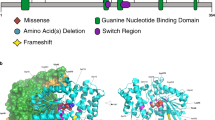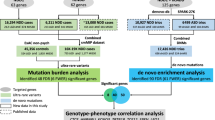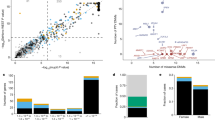Abstract
Despite three decades of successful, predominantly phenotype-driven discovery of the genetic causes of monogenic disorders1, up to half of children with severe developmental disorders of probable genetic origin remain without a genetic diagnosis. Particularly challenging are those disorders rare enough to have eluded recognition as a discrete clinical entity, those with highly variable clinical manifestations, and those that are difficult to distinguish from other, very similar, disorders. Here we demonstrate the power of using an unbiased genotype-driven approach2 to identify subsets of patients with similar disorders. By studying 1,133 children with severe, undiagnosed developmental disorders, and their parents, using a combination of exome sequencing3,4,5,6,7,8,9,10,11 and array-based detection of chromosomal rearrangements, we discovered 12 novel genes associated with developmental disorders. These newly implicated genes increase by 10% (from 28% to 31%) the proportion of children that could be diagnosed. Clustering of missense mutations in six of these newly implicated genes suggests that normal development is being perturbed by an activating or dominant-negative mechanism. Our findings demonstrate the value of adopting a comprehensive strategy, both genome-wide and nationwide, to elucidate the underlying causes of rare genetic disorders.
This is a preview of subscription content, access via your institution
Access options
Subscribe to this journal
Receive 51 print issues and online access
$199.00 per year
only $3.90 per issue
Buy this article
- Purchase on SpringerLink
- Instant access to full article PDF
Prices may be subject to local taxes which are calculated during checkout




Similar content being viewed by others
Accession codes
Data deposits
Data can be accessed at the European Genome Phenome Archive (https://www.ebi.ac.uk/ega/) under accession number EGAS00001000775.
References
OMIM. Online Mendelian Inheritance in Manhttp://omim.org (2014)
Cooper, G. M. et al. A copy number variation morbidity map of developmental delay. Nature Genet. 43, 838–846 (2011)
Allen, A. S. et al. De novo mutations in epileptic encephalopathies. Nature 501, 217–221 (2013)
de Ligt, J. et al. Diagnostic exome sequencing in persons with severe intellectual disability. N. Engl. J. Med. 367, 1921–1929 (2012)
Fromer, M. et al. De novo mutations in schizophrenia implicate synaptic networks. Nature 506, 179–184 (2014)
Iossifov, I. et al. De novo gene disruptions in children on the autistic spectrum. Neuron 74, 285–299 (2012)
Neale, B. M. et al. Patterns and rates of exonic de novo mutations in autism spectrum disorders. Nature 485, 242–245 (2012)
O'Roak, B. J. et al. Sporadic autism exomes reveal a highly interconnected protein network of de novo mutations. Nature 485, 246–250 (2012)
Rauch, A. et al. Range of genetic mutations associated with severe non-syndromic sporadic intellectual disability: an exome sequencing study. Lancet 380, 1674–1682 (2012)
Sanders, S. J. et al. De novo mutations revealed by whole-exome sequencing are strongly associated with autism. Nature 485, 237–241 (2012)
Zaidi, S. et al. De novo mutations in histone-modifying genes in congenital heart disease. Nature 498, 220–223 (2013)
King, D. A. et al. A novel method for detecting uniparental disomy from trio genotypes identifies a significant excess in children with developmental disorders. Genome Res. 24, 673–687 (2014)
Wright, C. F. et al. Genetic diagnosis of developmental disorders in the DDD study: scalable analysis of genome-wide research data. Lancet http://dx.doi.org/10.1016/S0140-6736(14)61705-0 (2014)
Smith, B. H. et al. Cohort profile: Generation Scotland: Scottish Family Health Study (GS:SFHS). The study, its participants and their potential for genetic research on health and illness. Int. J. Epidemiol. 42, 689–700 (2013)
Samocha, K. E. et al. A framework for the interpretation of de novo mutation in human disease. Nature Genet. 46, 944–950 (2014)
Boumil, R. M. et al. A missense mutation in a highly conserved alternate exon of dynamin-1 causes epilepsy in fitful mice. PLoS Genet. 6, e1001046 (2010)
Kumagai, K., Kawano, M., Shinkai-Ouchi, F., Nishijima, M. & Hanada, K. Interorganelle trafficking of ceramide is regulated by phosphorylation-dependent cooperativity between the PH and START domains of CERT. J. Biol. Chem. 282, 17758–17766 (2007)
Walter, G. & Ruediger, R. Mouse model for probing tumor suppressor activity of protein phosphatase 2A in diverse signaling pathways. Cell Cycle 11, 451–459 (2012)
Lim, E. T. et al. Rare complete knockouts in humans: population distribution and significant role in autism spectrum disorders. Neuron 77, 235–242 (2013)
Kettleborough, R. N. et al. A systematic genome-wide analysis of zebrafish protein-coding gene function. Nature 496, 494–497 (2013)
Pickart, M. A. et al. Genome-wide reverse genetics framework to identify novel functions of the vertebrate secretome. PLoS ONE 1, e104 (2006)
Craddock, N. & Owen, M. J. The Kraepelinian dichotomy—going, going... but still not gone. Br. J. Psychiatry 196, 92–95 (2010)
Jacquemont, S. et al. A higher mutational burden in females supports a “female protective model” in neurodevelopmental disorders. Am. J. Hum. Genet. 94, 415–425 (2014)
Levy, D. et al. Rare de novo and transmitted copy-number variation in autistic spectrum disorders. Neuron 70, 886–897 (2011)
Goriely, A. & Wilkie, A. O. Paternal age effect mutations and selfish spermatogonial selection: causes and consequences for human disease. Am. J. Hum. Genet. 90, 175–200 (2012)
Huang, N., Lee, I., Marcotte, E. M. & Hurles, M. E. Characterising and predicting haploinsufficiency in the human genome. PLoS Genet. 6, e1001154 (2010)
Helsmoortel, C. et al. A SWI/SNF-related autism syndrome caused by de novo mutations in ADNP. Nature Genet. 46, 380–384 (2014)
Acknowledgements
We dedicate this paper to J. Tolmie and L. Brueton for their unwavering and enthusiastic support of the Deciphering Developmental Disorders project. We thank the families for their participation and patience. We thank M. Daly and K. Samocha for access to unpublished mutation rate estimates. We are grateful to S. Saunders, D. Smedley, D. Conrad, A. Ramu and N. Huang for access to data and algorithms. We thank the UK National Blood Service and the Generation Scotland: Scottish Family Health Study for access to DNA from controls. Generation Scotland has received core funding from the Chief Scientist Office of the Scottish Government Health Directorates CZD/16/6 and the Scottish Funding Council HR03006. The Deciphering Developmental Disorders study presents independent research commissioned by the Health Innovation Challenge Fund (grant number HICF-1009-003), a parallel funding partnership between the Wellcome Trust and the Department of Health, and the Wellcome Trust Sanger Institute (grant number WT098051). The views expressed in this publication are those of the author(s) and not necessarily those of the Wellcome Trust or the Department of Health. The study has UK Research Ethics Committee approval (10/H0305/83, granted by the Cambridge South REC, and GEN/284/12 granted by the Republic of Ireland REC). The research team acknowledges the support of the National Institute for Health Research, through the Comprehensive Clinical Research Network.
Author information
Authors and Affiliations
Consortia
Contributions
See Supplementary Information for author contribution details.
Corresponding author
Ethics declarations
Competing interests
M.E.H. is a co-founder of, and holds shares in, Congenica Ltd, a genetics diagnostic company.
Extended data figures and tables
Extended Data Figure 1 Characteristics of the families.
a, Gestation-adjusted decimal age (years) at last clinical assessment. The histogram shows the distribution of the gestation-adjusted decimal age at last clinical assessment across the 1,133 probands. The dashed red line shows the median age. b, Frequency of human phenotype ontology (HPO) term usage. Bar plot showing, for each used HPO term, the number of times it was observed across the 1,133 proband patient records. c, Projection PCA plot of the 1,133 probands. PCA plot of 1,133 DDD probands projected onto a PCA analysis using four different HapMap populations from the 1000 genomes project. Black, African; red, European; green, east Asian; blue, south Asian; and the 1,133 DDD probands are represented by orange triangles. d, Self-declared and genetically defined consanguinity. Overlaid histogram showing the distribution of kinship coefficients from KING comparing parental samples for each trio. Green, trios where consanguinity was not entered in the patient record on DECIPHER; red, trios consanguinity was declared in the patient record on DECIPHER.
Extended Data Figure 2 Number of validated de novo SNVs and indels per proband.
Bar plot showing the distribution of the observed number of validated SNVs and indels per proband sample, and the expected distribution assuming a Poisson distribution with the same mean as the observed distribution.
Extended Data Figure 3 Number of diagnoses per gene.
Histogram showing the number of diagnoses per gene for genes with at least two diagnoses from different proband samples.
Extended Data Figure 4 Burden of large CNVs in 1,133 DDD proband samples.
Plot comparing the frequency of rare CNVs in three sample groups against CNV size. The y axis is on a log scale. Red, DDD probands who have not had previous microarray based genetic testing; purple, DDD probands who have had negative previous microarray-based genetic testing; green, DDD controls.
Extended Data Figure 5 Expected and observed numbers of de novo mutations.
The expected and observed numbers of mutations of different functional consequences in three mutually exclusive sets of genes are shown, along with the P value from an assessment of a statistical excess of observed mutations. The three classes of genes are described in the main text.
Extended Data Figure 6 Haploinsufficiency analyses.
a, Saturation analysis for detecting haploinsufficient developmental-disorder-linked genes. A box plot showing the distribution of statistical power to detect a significant enrichment of loss-of-function mutations across 18,272 genes in the genome, for different numbers of trios studied, from 1,000 trios to 12,000 trios. Line within the box shows the median, box shows the interquartile range and the whiskers show the most extreme values within 1.5 times the interquartile range from the box. b, Distribution of haploinsufficiency scores in selected sets of de novo mutations. Violin plot of haploinsufficiency scores in five sets of de novo mutations. Silent, all synonymous mutations; diagnostic, mutations in known developmental-disorder-linked genes in diagnosed individuals; undiagnosed_Func, all functional mutations in undiagnosed individuals; undiagnosed_LoF, all loss-of-function mutations in undiagnosed individuals; undiagnosed_recur, mutations in genes with recurrent functional mutations in undiagnosed individuals. P values for a Mann–Whitney U-test comparing each of the latter four distributions to that observed for the silent (synonymous) variants are plotted at the top of each violin. Dot indicates the median, box is interquartile range and whiskers are the most extreme values within 1.5 times the interquartile range from the box.
Supplementary information
Supplementary Information
This file contains detailed methods information for both human genetic analyses and animal modeling experiments, a list of author contributions; full legends for Supplementary Tables 1-8 and a full legend for the Supplementary Data file. (PDF 1179 kb)
Supplementary Information
This zipped file contains Supplementary Tables 1-8 – see the Supplementary Information document for full legends. (ZIP 835 kb)
Supplementary Data
This file contains Zebrafish modeling data - see the Supplementary Information document for a full legend. (PDF 6810 kb)
Rights and permissions
About this article
Cite this article
The Deciphering Developmental Disorders Study. Large-scale discovery of novel genetic causes of developmental disorders. Nature 519, 223–228 (2015). https://doi.org/10.1038/nature14135
Received:
Accepted:
Published:
Issue Date:
DOI: https://doi.org/10.1038/nature14135
This article is cited by
-
Explicable prioritization of genetic variants by integration of rule-based and machine learning algorithms for diagnosis of rare Mendelian disorders
Human Genomics (2024)
-
Statistical methods for assessing the effects of de novo variants on birth defects
Human Genomics (2024)
-
A novel DLG4 variant causes DLG4-related synaptopathy with intellectual regression
Human Genome Variation (2024)
-
GRID1/GluD1 homozygous variants linked to intellectual disability and spastic paraplegia impair mGlu1/5 receptor signaling and excitatory synapses
Molecular Psychiatry (2024)
-
A pigmentary manifestation associated with PPP2R5D-related neurodevelopmental disorder: a case report and review of literature
Bulletin of the National Research Centre (2023)



